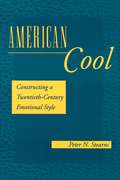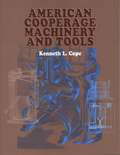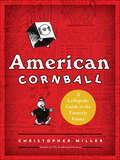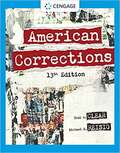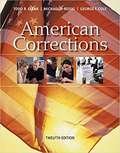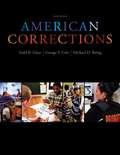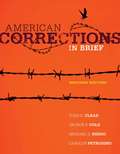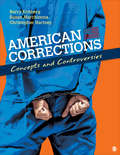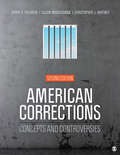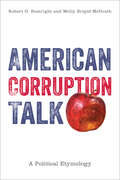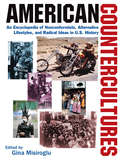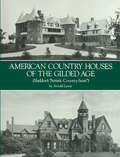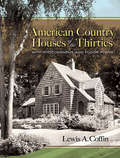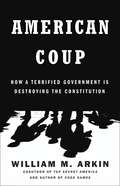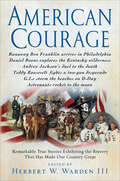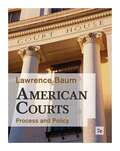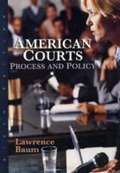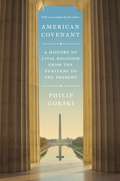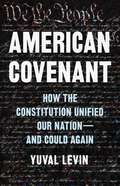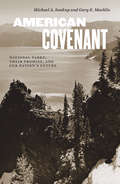- Table View
- List View
American Cool: Constructing a Twentieth-Century Emotional Style (History Of Emotions Ser.)
by Peter N. StearnsCool. The concept has distinctly American qualities and it permeates almost every aspect of contemporary American culture. From Kool cigarettes and the Peanuts cartoon's Joe Cool to West Side Story (Keep cool, boy.) and urban slang (Be cool. Chill out.), the idea of cool, in its many manifestations, has seized a central place in our vocabulary. Where did this preoccupation with cool come from? How was Victorian culture, seemingly so ensconced, replaced with the current emotional status quo? From whence came American Cool? These are the questions Peter Stearns seeks to answer in this timely and engaging volume. American Cool focuses extensively on the transition decades, from the erosion of Victorianism in the 1920s to the solidification of a cool culture in the 1960s. Beyond describing the characteristics of the new directions and how they altered or amended earlier standards, the book seeks to explain why the change occured. It then assesses some of the outcomes and longer-range consequences of this transformation.
American Cooperage Machinery and Tools
by Kenneth L. CopeThrough the second half of the 19th century and into the 20th, barrel makers followed the same path taken by many other woodworkers . . . they moved from hand tools to the large, efficient new machines that were the products of the Industrial Revolution. They built factories to house the machines and turned out thousands of barrels, kegs, and similar containers a day. Kenneth Cope?s book, in the pattern of his previous books on the American machine tool industry, provides more than 530 illustrations of these cooperage tools, taken from original catalogs and contemporary periodicals. Along with the illustrations is a brief history of the individual maker, chronicling the various machines that each made. Included, as well, are reproductions of four catalogs: E. & B. Holmes 1891 catalog and ca. 1910 or 1915 Q catalog, L. & I.J. White 1912 catalog, and the D.R. Barton 1905 catalog. An illustrated glossary of terms used and an appendix giving a brief look at the English and French cooperage industries in the corresponding period are also provided.
American Cornball: A Laffopedic Guide to the Formerly Funny
by Christopher MillerAmerican Cornball is Christopher Miller's irresistibly funny illustrated survey of popular humor—the topics that used to make us laugh, from hiccups and henpecked-husbands to outhouses and old maids—and what it tells us about our country yesterday and today.Miller revisits nearly 200 comic staples that have been passed down through our culture for generations, many originating from the vaudeville age. He explores the (often unseemly) contexts from which they arose, why they were funny in their time, and why they eventually lost their appeal. The result is a kind of taxonomy of humor during America's golden age that provides a deeper, more profound look at the prejudices, preoccupations, and peculiarities of a nation polarized between urban and rural, black and white, highborn and lowbrow.As he touches on issues of racism and sexism, cultural stereotypes and violence, Miller reveals how dramatically our moral sensibilities have shifted, most notably in the last few decades. Complete with more than 100 period illustrations, American Cornball is a richly entertaining survey of our shifting comic universe.
American Corrections
by George F. Cole Todd R. Clear Michael D. ReisigLearn more about the dynamics of today's correctional system in the U.S. with the fascinating, current content and balanced approach in Clear/Reisig/Cole's market-leading AMERICAN CORRECTIONS, 13E. <p><p> Engaging discussions, actual cases with familiar names and first-hand insights from those in the system immediately grab your interest, while career overviews point to rewarding opportunities in the field. You examine the latest facts and figures as well as new developments and trends impacting correctional policy and practice in the U.S., such as COVID-19 and the rising use of methamphetamines and opioids. <p><p> The authors provide an unbiased treatment of institutional and community sanctions as this well-rounded introduction examines the U.S. correctional system from the perspectives of both the corrections worker and the accused person. MindTap digital resources are also available with interactive learning tools, video cases and career scenarios that bring content to life.
American Corrections (Mindtap Course List)
by George F. Cole Todd R. Clear Michael D. ReisigExplore the American corrections system from the perspective of both the corrections worker and the accused person in AMERICAN CORRECTIONS, 12th Edition. You'll learn about institutional and community sanctions, aided by high-profile corrections cases taken from recent headlines to reinforce important theories. The authors "tell it like it is" with thought-provoking, unbiased examinations of such topics as assisting felons during the re-entry process, reducing recidivism, the death penalty and surveillance. You'll also get a frontline view of careers in the corrections field.
American Corrections (Tenth Edition)
by George F. Cole Todd R. Clear Michael D. ReisigExplore the American corrections system from the perspective of both the corrections worker and the offender in AMERICAN CORRECTIONS, Tenth Edition. Comprehensive yet not overwhelming, the book covers both institutional and community sanctions, incorporating high-profile corrections cases taken from recent headlines to reinforce important theories. The authors "tell it like it is," offering you thought-provoking, unbiased examinations of such topics as assisting felons during the re-entry process, reducing recidivism, the death penalty, and surveillance. You'll also get a frontline view of careers in the corrections field.
American Corrections In Brief (Second Edition)
by George F. Cole Todd R. Clear Michael D. Reisig Carolyn PetrosinoA condensed, more accessible version of the best-selling corrections book on the market, AMERICAN CORRECTIONS IN BRIEF, 2nd Edition, introduces readers to the dynamics of corrections. Complete with valuable career-based material, insightful guest speakers, illuminating real-world cases, and uniquely even-handed treatment of institutional and community sanctions, the book examines the U.S. correctional system from the perspectives of both the corrections worker and the offender, providing readers with a well-rounded, balanced introduction to corrections.
American Corrections: Concepts and Controversies
by Barry A. Krisberg Susan Marchionna Christopher HartneyAmerican Corrections: Concepts and Controversies, by Barry Krisberg, Susan Marchionna, and Chris Hartney, presents an incisive view of every aspect of corrections (including jails, probation, sentencing, prisons, and parole), prompting students to think critically about the complex issues involved in responding to the current crisis in the U.S. correctional system. Incorporating theory, research, and the most recent available data, the book takes a contemporary and issues-oriented approach as it explores the most interesting and progressive developments in correctional policy and practice. Students will come away with practical knowledge, as well as a framework for thoughtful analysis of a subject that can seem mysterious or impenetrable. In addition, the book covers subjects many corrections texts treat only minimally, including women in corrections, the death penalty, and special populations. Perhaps most importantly, the book offers a point of view on what is plaguing the American correctional system and a realistic look at the solutions that offer real promise.
American Corrections: Concepts and Controversies
by Barry A. Krisberg Susan Marchionna Christopher HartneyAmerican Corrections: Concepts and Controversies, by Barry Krisberg, Susan Marchionna, and Chris Hartney, presents an incisive view of every aspect of corrections (including jails, probation, sentencing, prisons, and parole), prompting students to think critically about the complex issues involved in responding to the current crisis in the U.S. correctional system. Incorporating theory, research, and the most recent available data, the book takes a contemporary and issues-oriented approach as it explores the most interesting and progressive developments in correctional policy and practice. Students will come away with practical knowledge, as well as a framework for thoughtful analysis of a subject that can seem mysterious or impenetrable. In addition, the book covers subjects many corrections texts treat only minimally, including women in corrections, the death penalty, and special populations. Perhaps most importantly, the book offers a point of view on what is plaguing the American correctional system and a realistic look at the solutions that offer real promise.
American Corrections: Concepts and Controversies
by Barry A. Krisberg Susan Marchionna Christopher Hartney"It is a thorough and focused work on American corrections providing a solid opportunity for students to learn not only how the correctional system works but also to understand its ever increasing complexities." —Dorie Astle, Southwestern Oklahoma State University American Corrections, Second Edition offers students a contemporary, issues-oriented introduction that covers every aspect of corrections, prompting students to think critically about complex issues that are affecting the current U.S. correctional system. Incorporating the most recent theory, research, and data available, the Second Edition encourages students to explore the most interesting and progressive developments in correctional policy and practice. Authors Barry A. Krisberg, Susan Marchionna, and Christopher J. Hartney draw from years of professional experience to give students a practical knowledge of corrections, as well as provide a framework for thoughtful analysis into what is plaguing the American correctional system and a realistic exploration of the solutions that could make a difference. SAGE Premium Video Included in the interactive eBook! Corrections News Clips bring extra coverage of current events into the book, connecting brief 2 to 4 minute news clips to core chapter content. Interactive eBook Includes access to SAGE Premium Video and other multimedia tools. SAGE coursepacks FREE! Easily import our quality instructor and student resource content into your school’s learning management system (LMS) and save time. SAGE edge FREE online resources for students that make learning easier.
American Corrections: Concepts and Controversies
by Barry A. Krisberg Susan Marchionna Christopher Hartney"It is a thorough and focused work on American corrections providing a solid opportunity for students to learn not only how the correctional system works but also to understand its ever increasing complexities." —Dorie Astle, Southwestern Oklahoma State University American Corrections, Second Edition offers students a contemporary, issues-oriented introduction that covers every aspect of corrections, prompting students to think critically about complex issues that are affecting the current U.S. correctional system. Incorporating the most recent theory, research, and data available, the Second Edition encourages students to explore the most interesting and progressive developments in correctional policy and practice. Authors Barry A. Krisberg, Susan Marchionna, and Christopher J. Hartney draw from years of professional experience to give students a practical knowledge of corrections, as well as provide a framework for thoughtful analysis into what is plaguing the American correctional system and a realistic exploration of the solutions that could make a difference. SAGE Premium Video Included in the interactive eBook! Corrections News Clips bring extra coverage of current events into the book, connecting brief 2 to 4 minute news clips to core chapter content. Interactive eBook Includes access to SAGE Premium Video and other multimedia tools. SAGE coursepacks FREE! Easily import our quality instructor and student resource content into your school’s learning management system (LMS) and save time. SAGE edge FREE online resources for students that make learning easier.
American Corruption Talk: A Political Etymology
by Robert G. Boatright Molly Brigid McGrathAmericans often worry about political corruption—not only about specific officials misusing their powers, but also more broadly about political, cultural, moral decay or deterioration. Underneath our talk about corruption lie deeper claims and concerns about how we organize our common life. American Corruption Talk presents a study of corruption and corruption talk that seeks to understand those deeper claims and concerns. Robert Boatright and Molly Brigid McGrath focus on the role corruption talk plays in American political discourse. They distinguish between two ways people speak about corruption—corruption talk in the style of a purifier, who wishes to expunge the evil forces or drain the swamp, and corruption talk in the style of the mender, who thinks of managing, replacing, or repairing. American Corruption Talk begins by tracing how the concept of political corruption was developed by philosophers and political thinkers, leading up to its use in the American context, especially in the Progressive Era. It also compares modes of contemporary corruption talk in different areas of public life. In doing so, the authors hope to resolve confusion and partisan disagreements about what corruption is and to discourage the tendency to label actions, events, and ideas that we merely disagree with as corrupt.
American Countercultures: An Encyclopedia of Nonconformists, Alternative Lifestyles, and Radical Ideas in U.S. History
by Gina MisirogluCounterculture, while commonly used to describe youth-oriented movements during the 1960s, refers to any attempt to challenge or change conventional values and practices or the dominant lifestyles of the day. This fascinating three-volume set explores these movements in America from colonial times to the present in colorful detail. "American Countercultures" is the first reference work to examine the impact of countercultural movements on American social history. It highlights the writings, recordings, and visual works produced by these movements to educate, inspire, and incite action in all eras of the nation's history. A-Z entries provide a wealth of information on personalities, places, events, concepts, beliefs, groups, and practices. The set includes numerous illustrations, a topic finder, primary source documents, a bibliography and a filmography, and an index.
American Country Houses of the Gilded Age: (Sheldon's "Artistic Country-Seats") (Dover Architecture)
by A. LewisThe "Gilded Age," the three decades following the Civil War, were years of astounding economic growth. Vast empires in oil, shipping, mining, banking, lumber, transportation, and related industries were formed. It was an era in which fortunes were made and lost quickly, almost easily; a period that encouraged - nearly demanded - the public display of this newly acquired wealth, power, and prestige. It was during these heady, turbulent years that a new type of domestic architecture first appeared on the American landscape. Called the "country seat" or "cottage," these houses were grandiose in scale - imposing facades complemented by manicured gardens, with exceptionally large and impressive reception rooms, halls, parlors, dining rooms, and other public areas. Intended exclusively for the very well-to-do, these buildings were designed by some of the finest and most influential architectural firms in America: McKim, Mead & White; Bruce Price; Peabody & Stearns; Theophilus P. Chandler, Jr.; Lamb & Rich; Wilcox & Johnston; and many others. The first, best, and most exquisite documentation of this surge of architectural creativity was the 1886-87 publication of George William Sheldon's Artistic Country-Seats: Types of Recent American Villa and Cottage Architecture with Instances of Country-Club Houses. It presented exceedingly fine photographs, clearly detailed plans and elevations, as well as Sheldon's own commentary for a total of 97 buildings (93 houses and 4 casinos). Most structures were located in new England and the Middle Atlantic states, and embraced the full spectrum of architectural and artistic expressions. This present volume reproduces all of Sheldon's fascinating and historically important photographs and plans, and adds a new, thoroughly accurate text by Arnold Lewis (Professor of Art, the College of Wooster, Wooster, Ohio) that includes the most useful information supplied by Sheldon and also reports on the present condition of each house or casino, providing analyses of elevations and plans, observations about family life in the 1880s, and brief biographical comments about the clients and architects. Sheldon's photographs connect us with a time and style of living that today increasingly seem more the realm of fiction than fact. Yet, in the pages of this important collection, they are brought fresh to life as they appeared when they were new and times were very different.
American Country Houses of the Thirties: With Photographs and Floor Plans
by Lewis A. CoffinAbout 1912, a renaissance of interest in early American architecture occurred that claimed the attention of a broad cross-section of the culture. It was demonstrated not only by being a popular topic in books and magazines, but also by the public's passion for collecting American antique furniture, and by students and architects traveling through different regions of the nation and photographing the most notable architectural examples. In the 1930s, the classic constructions from this earlier time mingled with the new materials and efficient designs, and the great American country house was born. This treasury showcases some of the finest American country houses produced during that unusually fruitful period. Culled from many of the best architectural firms of the time, the volume includes numerous detailed floor plans, lively sketches, and breathtaking photographs of exteriors and interiors. From simple cottages to functional family homes to sprawling estates, a wide variety of styles is represented. Celebrating the stately form, quiet technique, and balance and simplicity that is at the heart of every well-built American country house, anyone interested in history, art, and architecture will find in this collection an inspiring vision.
American Coup: How a Terrified Government Is Destroying the Constitution
by William M. ArkinA stunning exploration of the subtle erosion of freedom in an age of concocted fear and de facto military authority. When we think of a military coup, the first image that comes to mind is a general, standing at a podium with a flag behind him, declaring the deposing of elected leaders and the institution of martial law.Think again.In AMERICAN COUP, William Arkin reveals the desk-bound takeover of the highest reaches of government by a coterie of "grey men" of the national security establishment. Operating between the lines of the Constitution this powerful and unelected group fights to save the nation from "terror" and weapons of mass destruction while at the same time modifying and undermining the very essence of the country. Many books are written about secrecy, surveillance, and government law-breaking; none so powerfully expose the truth of everyday life in this state of war.
American Courage
by Herbert W. Warden IIIDrawn from firsthand and historical writings, this book gives voice to the pilgrims, founding fathers, revolutionaries, pioneers, '49ers, cowboys, soldiers, pilots, and the many other heroes who have built the nation.
American Courage: Remarkable True Stories Exhibiting the Bravery That Has Made Our Country Great
by W. Herbert Warden III“Readers would have a hard time finding a book more inspiring than American Courage.” — The Sunday Oklahoman
American Courts: Process and Policy
by Lawrence BaumThe highly respected AMERICAN COURTS: PROCESS AND POLICY, by top Courts scholar Lawrence Baum, provides clear descriptions of the courts and the activities of the various courts. The Seventh Edition explains what courts do, how people within them behave, and how they relate to the rest of the political system.
American Courts: Process and Policy (6th edition)
by Lawrence BaumThis highly respected text by leading scholar Lawrence Baum provides thorough descriptions of the courts and their activities; explanations of what courts do, how people within them behave, and how they relate to the rest of the political system; and an evaluation of the courts' work. The best-seller for political science or pre-law courses in the judicial process or judicial politics, American Courts is the most comprehensive, current, and accessible text in its market.
American Courts: Process and Policy (Sixth Edition)
by Lawrence BaumFrom the preface: One goal of this book is descriptive-to show how courts operate and what they do. I look closely at the work of the various types of courts in the United States. I also examine the people and institutions that help to shape the courts' activities, including lawyers, litigants, and policy makers in the other branches of government. A second goal of the book is to explain what courts do and how they relate to the rest of the political system. To take one example, it is important to know that a high proportion of criminal cases are resolved through plea bargains, but it is also important to understand the forces that make plea bargaining so common. Throughout this book, I consider explanations for matters such as the president's choices of federal judges and the positions that Supreme Court justices take in the cases they decide. The mass media, the general public, and policy makers elsewhere in government constantly evaluate the courts. Much of that evaluation is negative. One consequence is an array of proposals to remedy what people perceive as the courts' failings. This book examines many of these proposals and shows that reforms often fail to achieve the positive effects that were sought. A third goal of the book is to help readers make informed judgments in evaluating both the current state of the courts and proposals for change.
American Covenant: A History of Civil Religion from the Puritans to the Present
by Philip GorskiWas the United States founded as a Christian nation or a secular democracy? Neither, argues Philip Gorski in American Covenant. What the founders actually envisioned was a prophetic republic that would weave together the ethical vision of the Hebrew prophets and the Western political heritage of civic republicanism. In this ambitious book, Gorski shows why this civil religious tradition is now in peril—and with it the American experiment.Gorski traces the historical development of prophetic republicanism from the Puritan era to the present day. He provides close readings of thinkers such as John Winthrop, Thomas Jefferson, Frederick Douglass, W.E.B. Du Bois, and Hannah Arendt, along with insightful portraits of recent and contemporary religious and political leaders such as Jerry Falwell, Pat Robertson, Ronald Reagan, George W. Bush, and Barack Obama. Gorski shows how the founders' original vision for America is threatened by an internecine struggle between two rival traditions, religious nationalism and radical secularism. Religious nationalism is a form of militaristic hyperpatriotism that imagines the United States as a divine instrument in the final showdown between good and evil. Radical secularists fervently deny the positive contributions of the Judeo-Christian tradition to the American project and seek to remove all traces of religious expression from the public square. Gorski offers an unsparing critique of both, demonstrating how half a century of culture war has drowned out the quieter voices of the vital center.American Covenant makes the compelling case that if we are to rebuild that vital center, we must recover the civil religious tradition on which the republic was founded.
American Covenant: A History of Civil Religion from the Puritans to the Present
by Philip GorskiThe long battle between exclusionary and inclusive versions of the American storyWas America founded as a Christian nation or a secular democracy? Neither, argues Philip Gorski in American Covenant. What the founders envisioned was a prophetic republic that would weave together the ethical vision of the Hebrew prophets and the Western political heritage of civic republicanism. In this eye-opening book, Gorski shows why this civil religious tradition is now in peril—and with it the American experiment.American Covenant traces the history of prophetic republicanism from the Puritan era to today, providing insightful portraits of figures ranging from John Winthrop and W.E.B. Du Bois to Jerry Falwell, Ronald Reagan, and Barack Obama. Featuring a new preface by the author, this incisive book demonstrates how half a century of culture war has drowned out the quieter voices of the vital center, and demonstrates that if we are to rebuild that center, we must recover the civil religious tradition on which the republic was founded.
American Covenant: How the Constitution Unified Our Nation—and Could Again
by Yuval Levin&“The most important voice in the political culture&” (Ben Shapiro) reveals the Constitution&’s remarkable power to repair our broken civic culture, rescue our malfunctioning politics, and unify a fractious America Common ground is hard to find in today&’s politics. In a society teeming with irreconcilable political perspectives, many people have grown frustrated under a system of government that constantly demands compromise. More and more on both the right and the left have come to blame the Constitution for the resulting discord. But the Constitution is not the problem we face; it is the solution. Blending engaging history with lucid analysis, conservative scholar Yuval Levin&’s American Covenant recovers the Constitution&’s true genius and reveals how it charts a path to repairing America&’s fault lines. Uncovering the framers&’ sophisticated grasp of political division, Levin showcases the Constitution&’s exceptional power to facilitate constructive disagreement, negotiate resolutions to disputes, and forge unity in a fractured society. Clear-eyed about the ways that contemporary politics have malfunctioned, Levin also offers practical solutions for reforming those aspects of the constitutional order that have gone awry. Hopeful, insightful, and rooted in the best of our political tradition, American Covenant celebrates the Constitution&’s remarkable power to bind together a diverse society, reassuring us that a less divided future is within our grasp.
American Covenant: National Parks, Their Promise, and Our Nation's Future
by Gary E Machlis Michael A SoukupAn intimate and candid account of our national parks and their strengths, vulnerabilities, and essential role in American life Part memoir, part critique, and paean to the value of national parks, American Covenant distills the experience and insights from two long careers in conservation. Michael A. Soukup and Gary E. Machlis show how the national parks are essential to maintaining the essence of our national heritage, and key to America&’s future in a changing climate and political landscape. Sharing real-world examples of both victories and defeats in protecting national parks, this candid, thoughtful book reminds us that the national parks are a promise—a covenant—within and between generations of Americans. The book is also a call to revitalize, reconstitute, reconfigure, and reform the National Park Service, which the authors believe is governed too much by outdated management practices and politics instead of a foundation of expertise and science.
